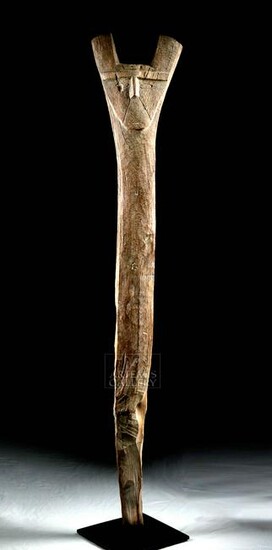Rare / Massive Huari Wooden Pillar
Pre-Columbian, south coast of Peru, Huari (Wari) culture, ca. 500 to 1000 CE. A massive wooden pillar, made from the wood of the huarango tree, with a long, cylindrical body that widens into a planar, triangular-shaped face and then branches into two thick horns. The face is classically Huari, the eyes set deep below a heavy browline, with a thin nose and incised eyes and small mouth. The horns may indicate that the anthropomorphic figure depicted is intended to be a shaman. Size: 12.55" W x 73" H (31.9 cm x 185.4 cm); 73.5" H (186.7 cm) on included custom stand.
What is this item? Was it made to be an architectural element, or to serve as a monument? A clue to its use lies at the archaeological site of La Estaqueria, located approximately two miles from the city of Cahuachi, in an area of southern Peru dense with archaeological monuments. This site was occupied by the Paracas, Nazca, and Huari, until around 1000 CE, when a flood of mud and sand devastated the area, probably following a historic rain event. It consists of 240 huarango posts, each placed about two meters away from the ones next to it, some ending in the shape of a fork, some with anthropomorphic and zoomorphic carvings. These may have supported a large roof, and many are found within the boundaries of a quadrangular enclosure. In the western part of the site, there is a very large huarango post which formed the axis of a circular roof, made of reeds tied with woven hair, that was found during excavation. Some researchers have thought that the pillars at the site were placed to create an astronomical observatory, but there is no clear evidence to support that theory. Instead, it seems likely that they were architectural pillars used to support the roof of a large indoor space, perhaps a public meeting space, with the carved anthropomorphic features decorative elements like gargoyles in a European cathedral.
Provenance: private Hawaii, USA collection; ex-private Hans Juergen Westermann collection, Germany, collected from 1950s to 1960s
All items legal to buy/sell under U.S. Statute covering cultural patrimony Code 2600, CHAPTER 14, and are guaranteed to be as described or your money back.
A Certificate of Authenticity will accompany all winning bids.
We ship worldwide to most countries and handle all shipping in-house for your convenience.
#143420
Condition Report: Surface cracks commensurate with age, but none that threaten the integrity of the piece. Some of the base may be lost but it is an ancient loss if so. Newer loss also low on the body (visible as the lighter strip in the photos).
View it on
Estimate
Time, Location
Auction House
Pre-Columbian, south coast of Peru, Huari (Wari) culture, ca. 500 to 1000 CE. A massive wooden pillar, made from the wood of the huarango tree, with a long, cylindrical body that widens into a planar, triangular-shaped face and then branches into two thick horns. The face is classically Huari, the eyes set deep below a heavy browline, with a thin nose and incised eyes and small mouth. The horns may indicate that the anthropomorphic figure depicted is intended to be a shaman. Size: 12.55" W x 73" H (31.9 cm x 185.4 cm); 73.5" H (186.7 cm) on included custom stand.
What is this item? Was it made to be an architectural element, or to serve as a monument? A clue to its use lies at the archaeological site of La Estaqueria, located approximately two miles from the city of Cahuachi, in an area of southern Peru dense with archaeological monuments. This site was occupied by the Paracas, Nazca, and Huari, until around 1000 CE, when a flood of mud and sand devastated the area, probably following a historic rain event. It consists of 240 huarango posts, each placed about two meters away from the ones next to it, some ending in the shape of a fork, some with anthropomorphic and zoomorphic carvings. These may have supported a large roof, and many are found within the boundaries of a quadrangular enclosure. In the western part of the site, there is a very large huarango post which formed the axis of a circular roof, made of reeds tied with woven hair, that was found during excavation. Some researchers have thought that the pillars at the site were placed to create an astronomical observatory, but there is no clear evidence to support that theory. Instead, it seems likely that they were architectural pillars used to support the roof of a large indoor space, perhaps a public meeting space, with the carved anthropomorphic features decorative elements like gargoyles in a European cathedral.
Provenance: private Hawaii, USA collection; ex-private Hans Juergen Westermann collection, Germany, collected from 1950s to 1960s
All items legal to buy/sell under U.S. Statute covering cultural patrimony Code 2600, CHAPTER 14, and are guaranteed to be as described or your money back.
A Certificate of Authenticity will accompany all winning bids.
We ship worldwide to most countries and handle all shipping in-house for your convenience.
#143420
Condition Report: Surface cracks commensurate with age, but none that threaten the integrity of the piece. Some of the base may be lost but it is an ancient loss if so. Newer loss also low on the body (visible as the lighter strip in the photos).



